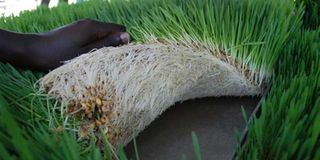Two young farmers make money with soil-less agriculture

A mat of barley growing on an aluminium tray. PHOTO | DENISH OCHIENG
What you need to know:
- Hydroponics is the process of growing crops without the use of soil
- The technique avoids soil to speed up growth while avoiding plant diseases
Childhood best friends Wachira Mwangi and Samuel Mbugua are teaching farmers a technique that may sound like the stuff of science fiction — growing crops without the use of soil and making a tidy sum out of it.
After a series of boring jobs and failed businesses the 26-year old University of Nairobi-trained biochemists tried to rear pigs early last year but the venture proved too expensive for the fresh graduates.
“We just wanted to keep a few pigs and see how it goes,” says Wachira, “but our biggest problem was the cost of feeding them. That was when my best friend Sam suggested that we grow our own fodder using a rare technology known as hydroponics”.
Hydroponics is the process of growing crops without the use of soil.
The technique avoids soil to speed up growth while avoiding plant diseases.
“What grows normally on soil for 21 days can take only six days if grown using the hydroponics technology,” says Mbugua.
You can grow pretty much anything using this soil-less method, but Mbugua and Wachira decided to grow livestock fodder because it not only saves space and time, but it is also cost-effective in pig farming.
After months of research, the pair started the business in July last year with a capital of Sh50,000. They used the money to fence the quarter acre plot belonging to Mbugua’s parents and bought 15 piglets to experiment with. They also acquired material to put up the required structures as well as barley seeds.
LIMITES SPACE
The pilot project worked so well, so much that farmers began trickling to their farm in Mwiki to be trained on how to grow hydroponic fodder.
So exactly how does the hydroponic technology work?
It works well for livestock farmers with limited space, time and resources because all a farmer requires is 45 cubic metres of space. For example a farmer with 15 cows will require only 5x3x3 metre (45 cubic metres) structure to grow enough fodder for all livestock.
“We spread the barley seeds evenly on aluminium trays and leave them to sprout, only watering them three times a day. In six days, you will have a network of roots and shoots and a mat of barley grass which is now ready for consumption by livestock,” says Mbugua.
Before spreading, the barley seeds will have been soaked in water for 48 hours so that they can sprout.
The 45 cubic metre structure accommodates up to 44 aluminium trays which can produce enough fodder to feed up to 25 mature pigs at Sh40 per day, compared to the commercial feed of which pigs consume three kilogrammes at Sh120 per day. The same structure also produces enough fodder to feed about 15 cows for a week as fresh fodder grows in the structure.
“Compare a 100 kilogramme bag of commercial feed to a similar bag of barley. Every kilo of barley yields about six kilos of fodder if you use the hydroponic technology but that is not the case with a bag of commercial feed,” says Wachira.
The quality of fodder is not only more nutritional than the conventional animal feed purchased in the shop but also means you don’t have to own acres to do it. This is because when the barley seeds sprout they release dormant nutrients of which 95 per cent of nutrients are useful to the livestock.
“This is a new technology in Kenya although it has been in existence for over 200 years. In UK and other countries, this kind of vertical farming is the trend. Israel is also using this technology because they have no soil to sustain agriculture. Kenyans do not want to be left behind,” says Mbugua.
BROKE EVEN
Every Saturday between 9am and noon, the pair hosts farmers at their farm in Mwiki for training at a fee of Sh500. However, their biggest income generator is constructing the structures for farmers who have now warmed up to the idea of using the soil-less technology to grow fodder for their livestock. The 45-cubic metre structure will cost a farmer up to Sh10,000 while a 30 cubic metre one goes for Sh6,000.
The two friends started the hydroponic business in July last year. By November they broke even and started raking in profits. In a good month they make between Sh150,000 and Sh200,000 depending on the season. Last month, they posted a profit of Sh150,000 in just three weeks from constructing the structures.
“People, especially the youth, are very receptive to this new technology. The youth have been practising this method in their farms; some even getting into trouble with their parents, but it is slowly gaining popularity. It is all about training and management,” says Wachira.
According to the two entrepreneurs, farming is a career just like any other, which the youth should seriously consider as employment. “It is a business just like any other. You have to be there to oversee it. If you don’t run your business, you will run out of business. You have to account for your money and do serious book-keeping. You must value your customers. The goal of any business is not for profit, but to satisfy your clients,” says Mbugua.
Relatives, friends and parents who wrote them off when they quit their jobs to start the business are now coming to them for consultation.
“My parents thought I was crazy to quit a well-paying job to feed pigs. Relatives were concerned. They thought I would hit rock bottom and go back to job-hunting. Many expected us to fail but after three months they believed in our vision,” says Mbugua.





